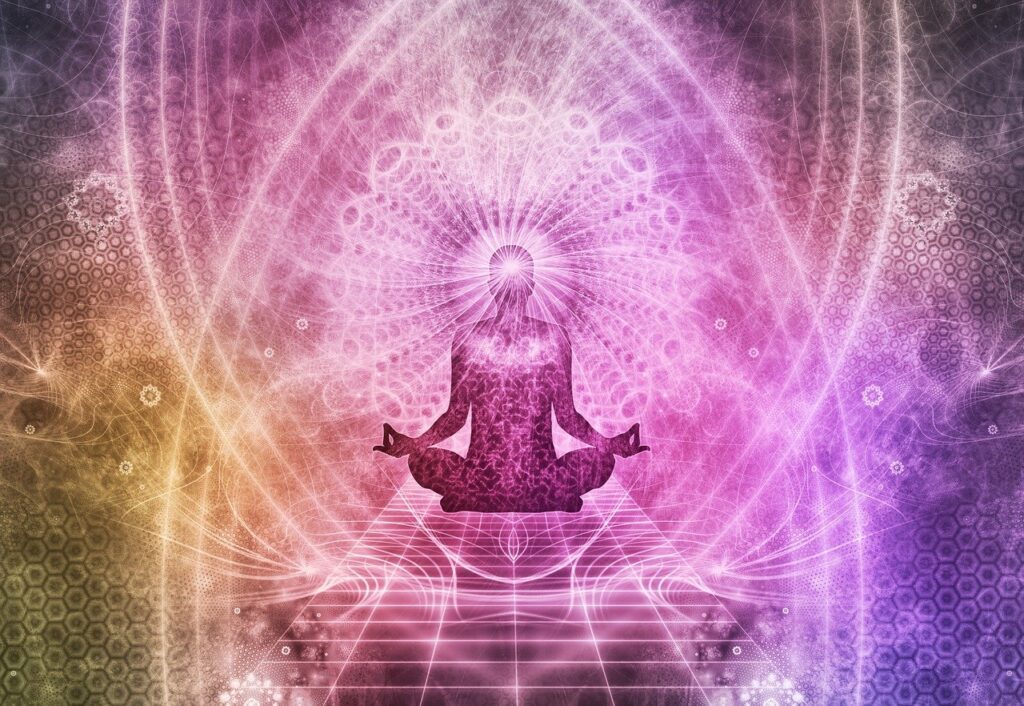The Totality of Meditation

In this past week’s reading of Tree of Yoga, BKS Iyengar focuses specifically on meditation as an integral part of the practice of yoga. Meditation (Dhyana) is not a separate “practice”. It is a culmination of the six limbs that precede it. Yama and Niyama are the foundation that supports Asana, Pranayama, and Pratyahara. Dharana, Dhyana, and Samadhi are the effects of the previous limbs. They are not “practiced” separately, but are the result of the integrated effort of all that came before.
Dharana, Dhyana, and Samadhi comprise an integrated experience referred to as Samyama (YS III.1-4). Drawing a distracted mind over and over again towards one single point is Dharana. Maintaining this steady mind without wavering in awareness is when “meditation happens” – Dhyana. Beyond this point, words begin to fail us, since within Samadhi, we are united with our own Self, no longer experiencing “I”. This experience is the product of the integration of consciousness enabled by our practice of the eight limbs of yoga. As consciousness is the river that runs through our whole embodiment, we cannot let any part of the river be neglected or dammed apart from the rest. There is no limb of yoga, from the external to the innermost layers, more important than another.
“How can you say that you are interested in the river of the mind or the river of the soul while neglecting the river of the body? How can you discard some of the limbs of yoga, saying that they are merely physical, while meditation is spiritual? Meditation is not separate from yoga, nor is asana separate from yoga. If you accept one part of yoga…, how can you discard the other parts?”
When we realize that the mind is contained in all of the body, we can understand that the river of consciousness can be followed for an uninterrupted path back to our whole Self. You may have experienced some moment in time when you have been in “that space between” where all is quiet and peaceful – the moment between thoughts, the moment after action and before reaction, the space between rising and falling movements of the consciousness. But soon enough, another thought or distraction comes. It takes effort to transform our consciousness into the free-running river with no hindrances.
At first the acts of yoga are effortful and compartmentalized. But through our practices on the mat and in the world, we start to realize that bringing the seemingly disparate parts of our being together makes all of life more “in flow”. “Meditation” is not sitting apart from life and the world, but becoming fully aware and conscious of our divine Self within the world despite all the external distraction. Meditation happens when our inner and outer experiences are integrated fully with our divine nature.
“We cannot become God, though we can become divine. And that divinity of life where the pleasures of the world and the pleasures of the spirit are evenly balanced is only possible to a man whose intellect is equal to the light of his soul.”
BKS Iyengar knew that this path was difficult, especially as modern life moved further and further into more external distraction, more accumulation, and more separation. Yoga exists because all humans tend to look more outside themselves for purpose and meaning instead of back within themselves. Far from being aimed at isolation or aloneness, meditation is to experience the fullness of ourselves. We cannot just put the body aside and train the mind. The body is one of our best tools to feel, to experience, and to reconnect to our own consciousness. The 5 active limbs of yoga remind us of this. We just have to take on the challenge!
“Until the finite is known, how can we touch the infinite?”
Patanjali’s Yoga Sutras (YS I.22), along with other ancient texts, give us many cues for self reflection on the stages of learning we may experience as students of yoga. We have to remember that the stages may not be linear, since layers of wisdom are built around the many layers of our being:
- Arambhavastha (Mrdu): Mild, beginner mind that runs at the surface, needs external and very clear instruction to connect the dots
- Ghatavastha (Madhya): Medium, making mental connection of the mind to the workings of the whole of the body, building sensitivity in movement
- Parichayavastha (Adhimatra) : Intense, building relationship of the body and mind through intelligence and acquaintance, skillful in mental quietude
- Nispattyavastha (Tivra samvegin): Supremely intense, no more “doing”, a ripe and full experience of “being”
Life is busy now, we all have various aspects of our life and being in the world that may or may not be seen as “conducive” to yoga. However, yoga is a universal practice for a reason and no matter where we are and who we are in time and place and culture, some aspect and degree of practice is possible.
Let’s finish out our Summer Book Reading of Tree of Yoga this week with Part Five, “Yoga in the World”.
Join Us for Discussion on Saturday, Aug 23 from 9:00-11:00am